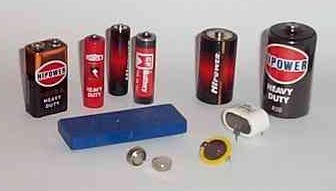
|
|
||
Batteries

Batteries are the most common source of portable power. All batteries work by converting stored chemical energy into usable electrical energy. Batteries are either single cell, like a typical cylindrical torch battery, or multi-cell, with the cells connected in series as in a car battery.
Circuit Symbol

There are two basic types:
Primary cells
These are disposable non-rechargeable items. Common types are based on a variety of chemistries such as the old 1.5 Volt Zinc Carbon torch batteries that have now been widely superseded by Zinc Chloride for general purpose and light duty usage as the latter have a higher energy capacity.
Alkaline batteries (strictly Alkaline Manganese Dioxide) offer improved characteristics such as lower internal resistance and thus allow higher current drain and increased energy density providing longer life while still providing 1.5V.
Various Lithium batteries are available which typically exhibit a voltage around 3V per cell, although some 1.5V variants are available. These are usually designed for low current operation over relatively long periods and have an excellent shelf life of 10 years.
Another low current battery is the coin or button cell, which is based on Silver Oxide. These are popular in applications like watches and cameras as they exhibit a terminal voltage (1.55V) that stays almost constant throughout the life of the battery.
Zinc-Air batteries function by reacting with the free oxygen in the air. These 1.4V cells are supplied sealed (and have an unlimited shelf life in this state), they are only 'opened' when they are to be used, as they have a very short life of only a few tens or hundreds of hours. Their advantage is a very high energy density, making them suitable for applications such as hearing aids and short-term telemetry or medical usage.
Secondary or Rechargeable cells
These are generally seen as a convenient cost effective alternative to disposable batteries, especially in high usage situations. The Nickel-Cadmium or Ni-Cad has been around for sometime but suffers a number of problems. It has a lower capacity than the equivalent primary cell and suffers from memory effect, which requires the battery to be fully discharged prior to charging to ensure it delivers its maximum capacity. Its advantage in many situations is its very low internal resistance, which allows it to deliver very high currents compared with many alternative technologies.
Nickel-Metal Hydride is a newer more environmentally friendly technology (it has no Cadmium) that has all the advantages of Ni-Cad with increased capacity and no memory effect. Both these technologies have a nominal voltage of 1.2V.
A more modern alternative is the Lithium Ion batteries, like those found in most Laptop computers. These have a voltage of up to 4.2V, exhibit a high energy density and good recharging characteristics but the number of charge-discharge cycles is limited. They are expensive but they have the potential to be made very thin (0.4mm) and in unusual shapes.
Lead Acid batteries are the oldest type of rechargeable batteries. Commonly found in cars they are heavy but can provide high capacities. The wet nature of these can prove to be a problem in some uses, but the advent of sealed lead acid types has overcome this problem. Lead acid cells have a terminal voltage of 2V but are often combined to form 6V, 12V and 24V commercial units, which are very rugged and can withstand significant abuse.
|
|












